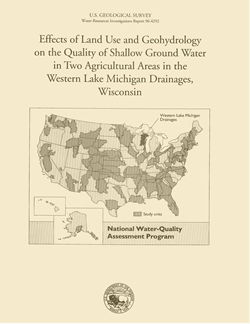Water-Resources Investigations Report 96-4292
Errata - Revised Janaury 2009

AbstractWater-quality and geohydrologic data were collected between September, 1993 and September 1994, from 56 wells and 2 springs, in two agricultural areas in the Western Lake Michigan Drainages study unit of the National-Water Quality Assessment Program. These data were used to study the effects of land use and geohydrology on shallow ground-water quality. Water samples from each well and spring were analyzed for major ions, nutrients, dissolved organic carbon, pesticides, volatile organic compounds, oxygen and hydrogen isotopes, and uranium; measurements of tempera ture, pH, specific conductance, and dissolved oxygen were made in the field. Ground-water samples were also analyzed for tritium or chlorofluorocarbons, or both, to estimate the recharge date of the ground water. Slug tests were performed on most of the wells to estimate the hydraulic conductivity of the surficial deposits in the vicinity of the well. The two areas chosen for study had similar agricultural land uses but different geohydrologic characteristics. Sampled monitor wells and springs were located down gradient from farm fields having similar crop rotation patterns, mainly corn and alfalfa. Area l is characterized by sand and clay surficial deposits overlying carbonate bedrock, and area 2 is characterized by sand and gravel surficial deposits overlying sandstone or crystalline bedrock. The depth to water was signif icantly deeper and the hydraulic conductivity of the surficial deposits was significantly higher in area 2. Water-quality analyses indicate that agricultural land use has affected the ground-water quality of both of the study areas, however, Wisconsin ground-water-quality enforcement standards were exceeded in only 22 percent (13 of 58) of samples for dissolved nitrate and 2 percent (l of 58) of samples for dissolved atrazine plus deethyl atrazine. There was a significant difference between the two areas in the concentrations of dissolved nitrate and atrazine plus deethyl atrazine in the shallow ground water. Although the amount of nitrogen fertilizer and manure applied to the land surface was similar or slightly higher in area 2, as compared to area 1, and atrazine application rates may have been slightly higher in area l, area 2 had significantly higher concentrations of both dis solved nitrate and atrazine plus deethyl atrazine in shallow ground water. The areal difference in nitrate and atrazine concentrations was likely due to the relatively higher permeability and lower organic matter content of the surficial deposits in area 2. The more permeable surficial deposits in area 2 allowed nitrate and atrazine (and its metab olites) to readily move from the land surface to ground water. Additionally, the lower organic matter content in area 2 helped to maintain higher dis solved oxygen concentrations in recharging water and throughout the saturated zone, thus reducing the possibility of denitrification or assimilative uptake. Estimated recharge dates showed that historic patterns of atrazine plus deethyl atrazine concentrations in ground water mimic historic patterns of atrazine use on corn. Concentrations in ground water that recharged prior to the early 1960s, when atrazine started to become widely used on corn in Wisconsin, were very low or not detectable. As atrazine use on corn steadily increased from the late 1960s to the late 1970s and early 1980s, detectable concentrations of atrazine plus deethyl atrazine in ground water became more common. The recharge dates of some of the highest measured concentrations of atrazine plus ethyl atrazine in ground water from both study areas correspond to the period of highest atrazine use on corn within the State. |
Printed 1997 For additional information contact: Part or all of this report is presented in Portable Document Format (PDF). The latest version of Adobe Reader or similar software is required to view it. Download the latest version of Adobe Reader, free of charge. |
Saad, D.A., 1997, Effects of land use and geohydrology on the quality of shallow ground water in two agricultural areas in the western Lake Michigan drainages, Wisconsin: U.S. Geological Survey Water-Resources Investigations Report 96-4292, 77 p.